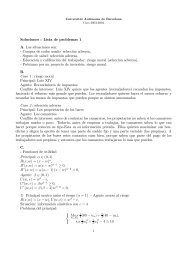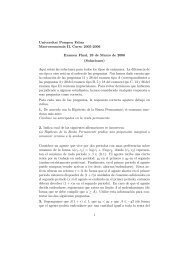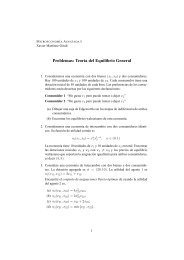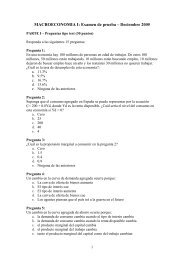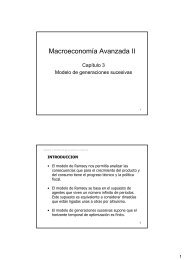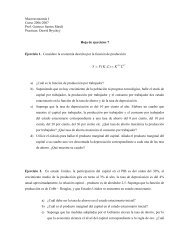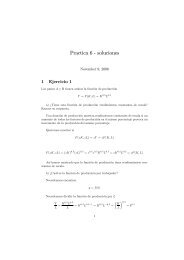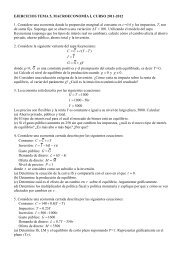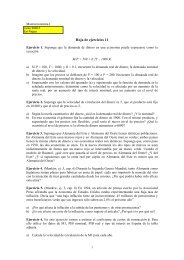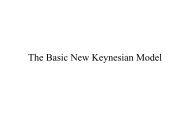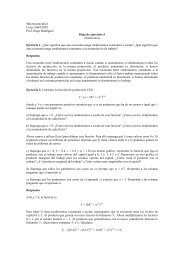Exercise 1 A monopolist has an inverse demand curve given ... - IDEA
Exercise 1 A monopolist has an inverse demand curve given ... - IDEA
Exercise 1 A monopolist has an inverse demand curve given ... - IDEA
You also want an ePaper? Increase the reach of your titles
YUMPU automatically turns print PDFs into web optimized ePapers that Google loves.
) Jo<strong>an</strong>’s nephew courses ADE/ECO at UPF <strong>an</strong>d argues that <strong>given</strong> their<br />
different dem<strong>an</strong>ds, the two groups should be charged different prices. In this<br />
case, what prices would he charge for men <strong>an</strong>d women How m<strong>an</strong>y hours<br />
would be dem<strong>an</strong>ded by each group What would BCN Sports’profits be<br />
c) Jo<strong>an</strong>’s niece also courses ADE/ECO at UP <strong>an</strong>d she suggests him to<br />
charge <strong>an</strong> entry fee in addition to the charge per hour. What prices would<br />
he charge as entry <strong>an</strong>d per hour for each group How m<strong>an</strong>y hours would be<br />
dem<strong>an</strong>ded in each group What would BCN Sports’ profit would be<br />
d) What option (among a), b) <strong>an</strong>d c)) would Jo<strong>an</strong> prefer What about<br />
the men What about the women Explain.<br />
Answers<br />
a) q M = 16 − p M <strong>an</strong>d q W = 20 − 2p W<br />
q M + q W = q = 36 − 3p ⇒ p = 12 − q 3<br />
π = 10q − 1 3 q2<br />
∆π<br />
∆q = 10 − 2 3 q = 0 ⇒ q = 15<br />
p = 12 − 1 3 q ⇒ p = 7<br />
π = pq − cq = 75<br />
b) π M = p M q M − 2q M = (16 − q M )q M − 2q M = 14q M − q 2 M<br />
∆π M<br />
∆q M<br />
= 14 − 2q M = 0 ⇒ q M = 7<br />
p M = 16 − 7 = 9<br />
π W = p W q W − 2q W = 8q W − 1 2 q2 W<br />
∆π W<br />
∆q W<br />
= 8 − q W = 0 ⇒ q W = 8<br />
p W = 10 − 4 = 6<br />
π = π M + π W = 9 ∗ 7 − 2 ∗ 7 + 6 ∗ 8 − 2 ∗ 8 = 81<br />
c) p∗ = MC = 2<br />
q M = 16 − 2 = 14 ⇒ F M = 1 (16 − 2) ∗ 14 = 98 (surface of a tri<strong>an</strong>gle<br />
2<br />
= 1 × height × base)<br />
2<br />
q W = 10 − 2 = 8 ⇒ F W = 1 (10 − 2) ∗ 16 = 64<br />
2<br />
Profits=consumers’surplus + profits per hour. But profits per hour=0<br />
(since p = MC). Therefore:<br />
π M = 98<br />
π W = 64<br />
π = π M + π W = 98 + 64 = 162<br />
d) which is the best option<br />
From the table, it is straightforward to see that the option c) is the best<br />
for the firm. For the men, it is a) <strong>an</strong>d for the women it is b).<br />
8



